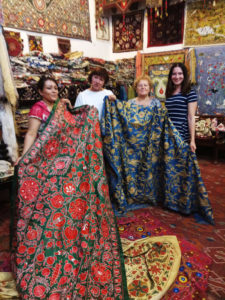Everything that you need to know about Uzbek suzane
Published: 1 November, 2017
Speaking about the art of embroidery, so the color plays the main role of the Uzbek people. Each suzane consists of fifteen tones. White, red, green and yellow colors prevail in art works. The canvases themselves are usually in gently peson or olive colours. One of the most popular is the embroidery called the “blooming garden”. These ornamental motifs symbolize happiness, prosperity, fertility. Moreover, sometimes, a stylized female silver jewelry with pendants of a tumor is beeing reproduced on suzane. Between bushes, branches, flowers, you can often see bright, motley birds. As a rare exception to certain products, you can find silhouettes of animals and people that are depicted somewhere on the side or on the edge. It should be noted that each region of Uzbekistan has its own individual style of suzane. For example, in Tashkent, people make red circles, from which the idea of drawing appeares later. In the Fergana Valley, the products are usually executed on dark green or purple silk or satin and they differ by a light elegant pattern freely placed over the unshielded background surface. A distinctive feature was the embroidery of Shakhrisabz, made on a colored background by a tambour seam, that is why these suzane resemble carpets more than embroidery.
Everyone knows that every woman have been known the art of embroidering in Uzbekistan since ancient times. It was possible to decorate almost everything with Uzbek embroidery: from interior to clothes. Today our story will be about a large embroidered panel, which decorats the walls, more known as suzane.
Decoratively embroidered suzane was prepared for the festive events of the family, for example, for weddings. They formed the obligatory part of the dowry and represented the kit necessary for the beginning of the life of the young family. The special importance was attached to the ornament of embroidered products, which were supposed to protect the newlyweds from evil forces.
Both technique and the embroidery images of each region are different, but what unites them irrespective of the region is the calorite of colors, the respect of old traditions and the poetic soul.



